Three-Day Backpack: Spanish Peaks Unit, Lee Metcalf Wilderness
Note: This report was written jointly by members of the expedition.
Authors' names precede their entries.
Mark:
On Friday, July 18, 1997, Kathy Sheehan delivered the six of us
(Frank, Ed, Sue, and Andrea Prosser, Vic Heng, and Mark Sheehan) to the
North Fork trailhead between the Meadow and Mountain Villages on the
road to the Big Sky resort between Bozeman and West Yellowstone,
Montana. We left the Sheehan's home in Hyalite Foothills south of
Bozeman at about 7am and arrived at the trailhead at about 8am. Kathy
returned home with the Sheehan's van and the hiking party set out on
the trail.
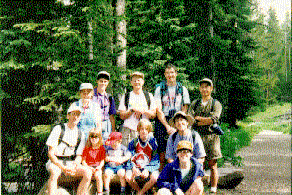
|
Sue:
I knew we were in for a beautiful trip when Kathy almost left with us.
It was so hard for her to turn the van around and go home, her eyes
longing for the trail. Before I could leave without a heavy guilt (she
and my mother- in-law, Brenda, were to take care of our young
children), I promised myself that someday we would all backpack
somewhere beautiful together, and Kathy would have center position on
the trail! The Sheehans' deep appreciation and knowledge of wilderness
is impressive. It will be a joyful expereince to do this again with
Kathy and Brenda.
|
The Extended Group - Front Row: Andrea
Second Row: Mark, Chloe, Sam, Mike, Brenda
Back Row: Kathy, Sue, Frank, Ed, Vic
|
|
Mark:
We began our hike north-northwest up the North Fork (of what, it has
never been clear to me) trail, starting at about 6,800 feet, and following
an old two-track road and single-track trail through private land
before entering the Gallatin National Forest.
Ed:
At about this point, we gave Frank's new GPS gizmo a try, and
discovered that we were actually 1.5 km from where the topo maps said
we were! Dead-reckoning 1, satellite navigation 0.
Mark:
We ran into light rain as we trekked up into the Spanish Peaks unit of
the Lee Metcalf Wilderness and to Bear Basin. Rain subsided after
about half an hour, and our ascent into the basin took place under
overcast skies. The hike up the North Fork trail into the basin (about
8,900 feet) had been mostly gradual but with occasional steep sections
that wore a bit on a couple of us. Spirits stayed high, nonetheless,
even as we climbed up from the basin to Summit Pass (9,670 feet) where
we had lunch in bright, windless conditions.
| 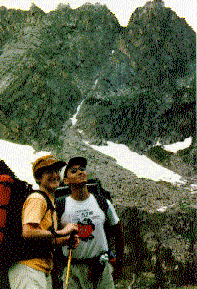
|
|
| Andrea and Vic Take in the Sights in Bear Basin
|
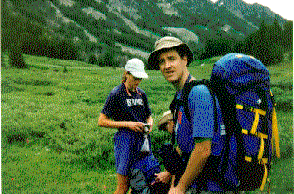
|
Frank:
On the north side of Summit Pass and before Summit Lake there remained
several substantial and steep snowfields, which all parties traversed and
descended with aplomb. I was impressed!
Mark:
After lunch, we made our way down the north side of the pass, turned east
onto the trail that leads past Summit Lake, and walked/glissaded down toward
Thompson Lake, at about 9,200 feet at the base of 11,000-foot Gallatin Peak.
|
| Ed and Sue Load Up to Tackle Summit Pass
|
|
|
It clouded up after we pitched our tents, but didn't threaten rain
immediately. Frank and I climbed up a side canyon to the Chilled
Lakes. On the way up we saw a lone coyote making its way along one of
the benches that overhung the valley below us. It stopped a couple
times as it skulked rapidly across the bench, turned, and looked
squarely at us.
| 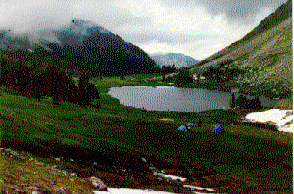
|
|
| Our Campsite at Thompson Lake
|

|
One of the Chilled Lakes, at about 9,600 feet, had a
snowfield at its edge that was calving off big hunks of ice into the
water. The other, a few hundred yards away and over a rise, was almost
entirely iced over. We saw the lakes, especially the latter, through
the fog at the base of a cloud and I, at least, was enchanted by the
whole scene.
Frank:
We both were impressed, but departed soon with reluctance as we
observed the weather rapidly closing in.
|
| Lower Chilled Lake
|
|
Mark:
When Frank and I returned from Chilled Lakes we had just enough time
to mix up our pudding and dangle it in its container from a cord into
a meltoff channel to chill before the wind picked up, the rain
started, and a thick carpet of hailstones fell, more or less all at
once. We found ourselves inside our tent, holding it up against the
wind and hail from the inside. If we hadn't been there to do that and
to replace the vestibule stake that pulled up, I think the wind would
have flattened the tent.
| 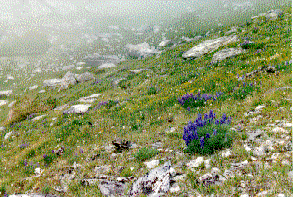
|
|
| Lupines in Fog, Chilled Lakes Area
|
Ed:
While Sue rested in the tent, out of harm's (and hail's) way, I
attempted to complete my pudding preparations just as the hail started
to come down. Thinking that the hail would last only a short time
while the first part of the storm blew through, and clad in my
semi-protective Gore-tex™ jacket, my first inclination was to
continue with my mixing. This state of overconfidence quickly gave
way to the "duck-and-cover" phase, as I tried to keep the hail from
striking my unprotected (Teva-clad) feet and head. As the hail
continued to grow in size, painfulness, and intensity, the pudding was
cast aside and I leapt into the tent. As I was licking my wounds, I
spotted Vic, wearing only a T-shirt, shorts, and sandals, running up
from Thompson Lake with some trout on his stringer. Ouch! When the
hail stopped, we had a pile about five inches deep in front of our
tent. Next time we'll have to consider bringing a snow shovel!
Sue:
It is a torn feeling, being inside a nice, dry, cozy tent, relaxing
after a tough half-day hike in your spanking clean and dry tent and
bag, and hearing the pained giggles of your loved ones outside the
tent getting pelted with hail that is coming down so hard that the
sides of the tent are caving in and the noise almost cuts out their
squeals, yells, and shocked laughter. Of course you want your buddies
to be protected from the elements, but also you want to keep your
belongings nice and dry. I must say it was a harsh change when Ed
unzipped the tent door and he, completely soaking with hail and rain,
leaped into the tent in addition to the seemingly buckets of hail and
rain that blew in with him! Vestibules may add to the pack weight,
but I can understand their importance in wet areas like the Spanish
Peaks.
Mark:
The storm passed 30-45 minutes later, and we were able to secure the
tent stakes, help clean Vic's fish (see below), and make dinner. Frank
and I cooked together, as did Ed and Sue, and as did Andrea and
Vic. We had three stoves, three sets of pots and pans, and three menus
among us.
While Frank and I were at Chilled Lakes, Vic had caught four cutthroat
trout in Thompson Lake, so he was able to satisfy his protein craving
as well as to share some (reportedly) luscious trout with the
others. I declined; having helped Vic clean the fish and having
fish-smell all over my hands, I wasn't eager to amplify the effect by
having the taste in my mouth, too. ...I'm a little squeamish about
fish even when my stomach is mellow, and it had been a little upset
for several days. I was also concerned about attracting bears. We
cooked 100 yards from camp, buried the fish guts even farther away,
hung our food from a cliff, and (I, at least) washed up with soap
before going to bed, but I still imagined I smelled like bear bait, if
only from the smoke of the frying fish that clung to my
jacket. Purists in the outback will put the clothes they cook in into
their food bags and hang them out of reach, hundreds of yards away
from camp. Grizzly country can be a scary place!
Frank:
As Vic was cooking his trout, he and I had been vigorously trying to
convince Mark that trout cheeks were a major delicacy. Trout cheeks
are small dime-sized muscles near the eye of the fish. They are very
tender, although it would take an ocean-full of trout to supply one
with a meal of cheeks. Mark was having none of this, believing that we
were spinning a yarn. Unfortunately, he was elsewhere when we ate the
cheeks, and he still doesn't believe us.
Mark:
Dinner was good. Frank and I had angel hair pasta with freeze-dried
vegetables and tuna, a fruit bar (like a very long, flattish Fig
Newton, but with strawberries or blueberries where the figs would be,
and a squiggle of white icing on top), and our pudding. The sad thing
about the pudding was that we'd added twice the water the recipe
called for and so wound up drinking dilute lemon pudding mix rather
than spooning down a nice semisolid dessert -- it was not milkshakey
enough to have been positively enjoyable, but was a little better than
dilute, lemon-flavored milk.
Frank:
Mark is too kind: I did the mixing, after having misplaced the
directions. This embarassment was extended into an amusing and bizarre
incident when we discovered that Andrea had mistaken the Handi-Wrapped
packets of milk powder for the pudding, and had in fact prepared an
extra-thick portion of skim milk!
Mark:
Lesson learned: I'm going to take flour tortillas or pita bread on
these trips in the future to aid in after-dinner cleanup. Doing dishes
in the wild is a pain; if I can dispose of garbage "down the hatch"
before it becomes garbage, it'll be much easier than digging a hole
and burying little bits and scraps of this and that, or packing them
out along with other trash. Frank advised us all, by the way, to pack
out our used toilet paper, and even offered empty Ziploc bags for
"used bumwad storage." The argument goes that in the backcountry
there's getting to be a wad of the stuff under every rock. In high,
especially high and dry country, it just doesn't biodegrade. I see a
time coming when backpackers will be expected, as cavers now are, to
pack out their poop in plastic bags.
Ed:
Sue and I had a very tasty meal. Starting with hummus and pita,
and moving on to the main course of porcini mushrooms, (canned) chicken,
couscous, and dried tomatoes. Topped off with the trout, this was quite
filling and the best backpacking meal I recall having for a long while.
Mark:
We all seemed at loose ends after dinner. We got the food hung up and
the next day's supply of water filtered, and -- had nothing else to do
between 6:30 and our 9-9:30 bedtime. We each lazed and wandered a
little, but finally Frank called us all together onto a big, flat rock
overlooking the lake where he read to us "The Cremation of Sam McGee"
by Robert W. Service. That coalesced the group nicely and we sat or
sprawled on the rock for at least an hour, telling jokes, teasing each
other, and talking. I was pretty quiet, as was Vic, we being the least
familiar with the other four.
Frank:
That evening we had discussed the possibility of climbing nearby
Gallatin Peak (about 11,000 feet) next day, but from our camp area we
could find no way up that looked to be within our competence, so we
abandoned the idea. Although after our trip a friend of Mark showed
him a suitable approach from the west, it's just as well we didn't
know of it, since the next morning's weather was certainly not
suitable for peak climbing.
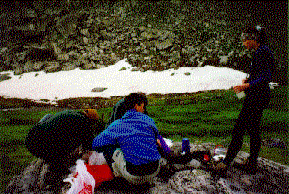
|
Mark:
I think we were all tired, and as a result slept well. The night was
uneventful, weatherwise. It had been 60 degrees at dinnertime Friday,
but 50 the next morning at breakfast. It started raining right after
our meal. We rode out one storm in our tents, then in the interval
before the next one packed up and hit the trail around 9:30. The hike
led us down the Hell Roaring Creek valley, past Thompson Lake, along
the base of the north slope of Gallatin Peak. The valley was pretty --
a bit soggy, made worse by the rain that began falling before we left
our campsite -- but the clouds were high and we had good views of the
mountains all around. We walked through pretty forests of limber pine
and Engelmann spruce, with lowbush blueberry plants covering the
forest floor. The trail was interrupted frequently by streams and
marshy spots, all of which we negotiated without incident.
|
| Breakfast Rock at Thompson Lake
|
|
Ed:
During the early morning rain, which delayed our departure, I came to
the conclusion that it is far more enjoyable (for me at least) to hike
in the rain than it is to sit in the rain. Perhaps because I get so
much enjoyment from the physical part of backpacking, I felt that
hiking in the rain was preferable to almost any other activity other
than hiking in nicer conditions.
Mark:
After a mile or so the rain let up, and the scenery continued to be
grand. We stopped on a shallow uphill grade to shed raincoats,
overpants, etc., then began the climb to Beacon Point, a mountaintop
at 10,224 feet, 1,600 feet above us. It was a long, wearying climb. From
the summit we had incredible views of the Spanish Peaks of the Madison
Range. I put on fleece jacket, raincoat and pants, took some photos,
ate some gorp, and wandered around the mountain top. It was close to
11am, as I recall. We walked east then, along Indian Ridge, which is a
spectacular couple miles of country, with the trail rising and falling
a few hundred feet here and there, but generally staying around 9,600
feet, either above timberline or just barely dipping into limber pine
forest.
Sue:
I knew we were in for a gorgeous reward for the seemingly brutal
conditions that met us on that climb. I know I haven't been through
all that much, but it was unnerving feeling like I was going to be
blown off the trail several times, only to fall down the steep rocks
below. Nevertheless, euphoria took over and I wanted to yodel and
sing and couldn't stop smiling the farther up I climbed. Even Frank,
who is to most a no-nonsense type, was grinning with delight at the
beauty. Andrea hiked up with Frank and me. She was cold and a bit
angry with the wind stealing her breath away just when she needed it
most, but she trudged up steadily and we all enjoyed the moment and
the view.
| 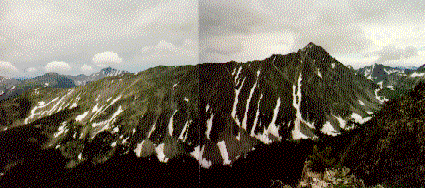
|
|
| Panorama of Gallatin Peak from Beacon Point
(click for enlargement)
|
Ed:
Climbing and summiting Beacon Point, although a bit chilly, was my
favorite part of the trip. You really had to earn that most excellent
view, but of course it was well worth every grunt and droplet of
sweat. I think I would be at my happiest just going uphill all day.
Too bad cycling does not prepare the knees well for the jarring
descents that follow climbs such as these.
Mark:
We had lunch about 2/3 of the way out the ridge, in a sheltered, piney
area overlooking the Gallatin Valley. The sun was out and warmed us
enough that a couple of us reverted to short pants (my rain pants had
been a welcome windstop on Beacon Point, but built up considerable
condensation inside as I hiked Indian Ridge). As we pressed on after
lunch we had fabulous views of the Spanish Peaks behind us. I stopped
and took a panoramic series of pictures from a high point near the end
of the ridge.
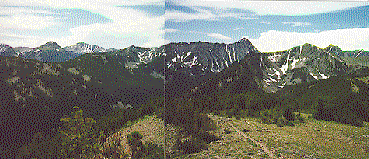
|
Frank:
As we ascended Beacon Point from the southeast, we had our first
views of Indian Ridge. For me, it was a breathtaking, unforgettable
moment. This ridge is a marvel, the likes of which I don't every
recall seeing, much less traversing. Even though the wind was blowing
us around, I was much excited by the long traverse of the ridge.
|
Gallatin Peak Area from Indian Ridge
(click for enlargement)
|
|
Mark:
Arrow Lake was our destination for the second night's camp. I'd never
camped there before (had never been over ANY of this ground before,
beyond our lunch spot the first day), but it turned out to be
excellent. There was good, clear drinking water in the lake (also lots
of leeches, so we didn't swim, despite the sunny weather). We filtered
the water through Sweetwater Guardian pump-type filters -- one
belonging to Andrea, the other mine. The lake plankton clogged the
filters so we had to clean them regularly -- unfortunately I'd
elected, based on faulty expectations of water clarity, not to bring
my filter cleaning brush along. I won't do that again! Andrea's brush
had been lost at Thompson Lake. We used toothbrushes for the job at
Arrow Lake instead (thanks to Ed's generosity and/or lax dental
hygeine habits while on the trail). (Kidding, there, Ed!)
I think it was worth the effort to pump the water. Our alternative was
to dose the water with iodine; I've always had a problem with making
water potable by making it poisonous. If it's poisonous enough to
kill bacteria and viruses and protozoa, it seems logical that it could
harm me. For decades, chlorination has bothered me for the same
reason. I grew up drinking chlorinated water and didn't mind the taste
at all, but I wonder if it wasn't really damaging -- I'd like to see
research data on the topic. I remember a stretch in the late '70s when
I avoided drinking tap water in Bloomington, Indiana, where I lived
most of my life, because it gave me a stomach ache -- likely having
more to do with algae from Lake Monroe, or with the chemicals used to
treat the water for the algae, than with the chlorine used to kill the
bacteria. ...And I've always felt good about drinking well water, the
times I've done that (1980-86 and 1996 to present). Anyway, I really
like the notion of filtration rather than chemical treatment, even if
it does take time. (Chlorine aside, Frank says he doesn't mind the
taste iodine imparts to the water; I find it unpleasant enough to
warrant some effort at avoidance, and got the impression that others
in the group agreed. Still, it was nice to have iodine as a backup!)
Arrow Lake is in a saddle between two adjoining parts of Indian
Ridge. It has no visible inlets or outlets, so in late summer,
especially if there's been a lot of horse traffic, I imagine it gets a
bit stagnant (and even harder to filter).
Ed:
This was the first time I used filtration to treat my water (Sue and I
bummed the use of Andrea and Mark's filters throughout the trip). I
liked the fact that, once you got done pumping a bottle's worth, it
was ready to drink; as opposed to iodine where it has to sit around
for a bit. It's a drag to pump 6 liters of water in preparation for
dinner and the following morning's breakfast, but I think that next
trip I will go the filter route and relegate the iodine to back-up in
case the pump breaks.
Mark:
Around 4:30pm, rainstorms blew up. They were brief, but sometimes
intense, with a little hail mixed in. Around 5pm we took advantage of
a lull to cook dinner. Frank's and mine was angel hair pasta with
vegetables again, but this time with a cheesy alfredo-type sauce and
beef sticks (Slim Jims) sliced into it. A very tasty variation on the
previous night's theme! The rest of the menu included a fruit bar and
chocolate pudding which, despite not having a snowbank to chill it in
as we had had at Thompson Lake, set up nicely and was a satisfying
dessert. To my appetite, the rations that night were a little sparse;
though I didn't complain, Frank apologized for it, so I assume he felt
the portion was a bit small, too. I could have comfortably eaten at
least half again as much pasta as I did. I didn't feel especially
hungry or empty after the meal -- I just could have eaten more. The
experience provided valuable information for planning future
cool-weather mountain trips.
Ed:
Under my direction, Sue and I erected our tent on a site where the
rain pooled in a few low spots and so we took some water in our tent.
While I was taking care of some personal hygiene, Sue (always the
diplomat) enlisted the help of the others to move our tent to a less
flat, and dryer, site. Thinking I would be angry that my original
choice was abandoned, I guess she figured that I wouldn't notice that
the tent had somehow "warped" to another location 10 meters away. I
was just thankful that the water damage was negligible, and will vow
to pay more attention to drainage in the future.
Mark:
After dinner the rain picked up again and we had wave after wave of
showers until bedtime, at about 9pm. Between dinner and bedtime we lay
in our tents andread a bit. With occasional help from Andrea, Frank
sang from Gilbert & Sullivan (I think) in his (to me surprisingly
resonant and competent) baritone. I read a few passages from my field
guide to Rocky Mountain plants, got a handle on the differences
between milkvetch and locoweed, and between limber and whitebark
pines, and tentatively identified some of the cushiony alpine plants
we'd seen in the past two days. Frank tried to take a run at reading
C.S. Lewis's Perelandra but there were too many distractions.
We all gradually dozed off, after taking advantage of some lulls in
the storms to attend to toothcare and toilet chores. During one such
lull I saw that a dusting of fresh snow had fallen on the north face
of Gallatin Peak, now 5-6 miles off in the distance.
I vividly remember wishing I could take a bath rather than contaminate
my sleeping bag with the smelly, sticky sweat I'd exuded over two days
-- but that's camping! If the sun had stayed out longer I might have
taken a sponge bath that second day using a bucket of leechless lake
water. I actually had time to do that -- can't say why I passed it up.
Sue:
That evening when we were tying up the food packs over a dead tree I
scrambled up a hill under some evergreens to get a long stick for the
task and was pretty certain I was looking at a bear paw track in the
dirt. Perhaps my suspicions were somewhat confirmed the next morning
when Vic mentioned a large animal silhouette that he thought he saw in
the middle of the night upon returning from a bathroom break. Andrea,
too, mentioned she heard noises that night and lost some sleep
worrying about bears. But, morning came and, thankfully, our food was
intact. Good thing Vic didn't find any trout in THAT lake!
Mark:
The third day we woke up above the clouds. There was a high overcast
above us, but the rainy, misty stuff was down in the valleys. We
breakfasted and set off early, making terrifically good time down the
trail to the trailhead at the Spanish Creek Recreational Site, where
Kathy and Brenda were to leave a car for us.
Frank:
The trail mostly followed the north side of Little Hell Roaring
Creek. Among the lodgepole pine and Douglas fir we made sure we were
making enough noise to alert even the deafest bear, and we saw
none. Unfortunately, making noise to avoid bears means you don't see
much other wildlife, but that's a necessary consequence of traveling
in bear country.
Mark:
We'd predicted we would reach the car early in the afternoon. In fact
it was more like 10:30 when the bulk of the party arrived at the
trailhead. It was essentially a downhill trek, and we were motivated
to get back to civilization/baths/kids/Doritos.
Sue:
Ted Turner has great taste in land. We hiked on an easement on his
land for the last several miles of the trek, and the meadows were a
beautiful sage green that rolled on and on for miles - such an
expansive, peaceful, gorgeous feel to it. While Frank and Mark were
swept up in a good conversation behind me, and Andrea loped along in
front of me to catch Vic and Ed ahead, I relished in my solitude on
the trail, gazing at fields of wildflowers that had me achi ng to take
pictures. Unfortuately in my attempt to pack lightly, I left out the
3 or so rolls of film that I'm sure I would have used here. After the
Indian Ridge hike, this section was my next favorite for its unique
beauty and the quiet solitude that it offered.
Mark:
I realized about half a mile from the parking lot that I'd
left my hiking staff leaning against a dead tree a mile back up the
trail. I cached my pack behind a fallen tree trunk and jog-walked back
up the trail to fetch the staff. Despite the clunky boots I was
wearing, I enjoyed the running. Some people do it for sport in better
shoes; I may take it up. It's incredible aerobic exercise, and gets a
person into the wilderness faster than any other legal way I know. A
friend of mine will sometimes do 20-30 mile runs on forest trails in
just a few hours. I think I'd like to do that. I've always had a
fascination for Indian "runners." I learned from a video on business
paradigms the other night that the
Tarahumara Indians of Mexico routinely run 70 miles at a
stretch. I suppose the biggest drawbacks to trail running as opposed
to mere hiking are the increased likelihood of severe injury from
trail hazards, inattention, etc., and the apparent attraction running
humans hold for cougars in predatory moods. Solo trail running is
discouraged by the local wildlands managers for this reason, and is
certainly unwise for other reasons. And of course that complicates
matters, especially for us introverts.
Frank retrieved my backpack from where it was stashed and humped it
back to the parking lot for me. I rejoined the group around 11:30 and
we all headed home.
Frank:
The hailstorm we experienced toward the end of our first day also
bombarded the Sheehan's neighborhood down near Bozeman. They
experienced hail approaching one inch -- larger than the half-inch
stuff we endured -- and considerable damage was done to hay, gardens,
and house sides.
After we arrived, the Sheehan's house became a very efficient laundry
and drying establishment, as the six of us tended to our generally wet
and dirty tents, clothes, and belongings. The weather was mean to us
on this trip, but, as I've observed on numerous hikes, climbs, and
backpacks, it's the tough times that get remembered as time
passes. Starting immediately after the trip the tough times don't seem
so tough. This was a fine trip in gorgeous country, thanks largely to
Mark's excellent groundwork. For me it was enhanced by the opportunity
to backpack with so many people I feel close to.
Ed:
The Spanish Peaks were indeed lovely. The high trail along Indian
Ridge during the second day's march was really quite remarkable. It
had been several years since my last backpack trip, and this trip left
me hungry for more. It was great to backpack with a group of family
and friends, and in particular, it was nice sharing the outdoors with
Sue.
One bummer was that we never had any difficulty finding our way, so we
couldn't use Dad's new GPS to help us navigate. I had secretly hoped
we would become hopelessly lost (perhaps in a dense fog) so the GPS
would have been of some real use. Maybe next time....
Constructed and maintained by
Mark Sheehan
Hop to my Tripod Trip Report Web site
Hop to
my
Montana State Web site